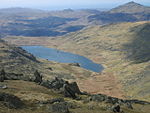Hardknott Pass
Mountain passes of the Lake DistrictRoads in CumbriaRoman roads in EnglandScenic routes in the United KingdomUse British English from March 2018

Hardknott Pass is a hill pass between Eskdale and the Duddon Valley in the Lake District National Park, Cumbria, England. The tarmac-surfaced road, which is the most direct route from the central Lake District to West Cumbria, shares the title of steepest road in England with Rosedale Chimney Bank in North Yorkshire. It has a maximum gradient of 1 in 3 (about 33%).
Excerpt from the Wikipedia article Hardknott Pass (License: CC BY-SA 3.0, Authors, Images).Hardknott Pass
Hardknott Pass,
Geographical coordinates (GPS) Address Website Nearby Places Show on map
Geographical coordinates (GPS)
| Latitude | Longitude |
|---|---|
| N 54.40269 ° | E -3.197118 ° |
Address
Hardknott Pass
Hardknott Pass
LA20 6EQ , Eskdale
England, United Kingdom
Open on Google Maps








